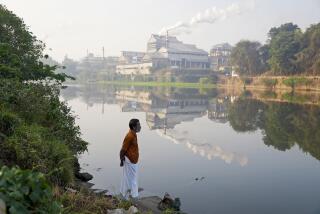China Finds Chemical Plants Pose Widespread Risk to Rivers
- Share via
BEIJING — More than 100 chemical plants on the banks of China’s rivers pose safety hazards that could jeopardize drinking water and spread contamination widely, China’s environment chief said Tuesday.
The announcement, based on a government survey of the nation’s 21,000 riverside chemical plants, amounts to a sobering acknowledgment by the Beijing government that rapid industrial development has outstripped the nation’s ability to regulate environmental hazards.
More than half of the riverside chemical plants sit on the banks of China’s most famous waterways, the Yellow and the Yangtze, which flow for thousands of miles and pass through population centers that depend on them for drinking water. Both are vital to crop irrigation as well.
Many of these plants had failed to conduct proper environmental impact studies and regularly dump untreated waste directly into the rivers, the survey showed.
The government conducted the survey after a chemical factory explosion in November that dumped 100 tons of benzene compounds into the Songhua River in northeast China’s Jilin province, forcing the city of Harbin to shut off water supplies to 3.8 million people for five days. The crisis forced the head of the State Environmental Protection Administration to resign.
Zhou Shengxian, the new environmental chief, said at a news conference that investigations were continuing and the offending factories would not be identified until later.
Zhou acknowledged that the problems were tied to the country’s fast-paced development, which has put economics ahead of the environment. But he said the country was working to change that.
“In the earlier years of China’s development, we sacrificed the environment in exchange for economic gains,” Zhou said. “Now the Chinese government has made a timely decision to stop the conventional approach to development, which could be characterized as destruction and pollution first, treatment later.”
Although China has enacted national environmental laws, businesses and local officials have easily subverted them, environmentalists say.
As a result, the government reports that as many as 300 million rural residents drink contaminated water and about 90% of China’s cities have polluted groundwater.
Environmental problems and the lack of proper legal channels for addressing grievances have contributed to growing public anger and unrest. Last year, the national police registered a record 87,000 protests, up from 74,000 in 2004.
Although the causes of unrest include allegations of corruption, illegal land grabs and unpaid wages, environmental degradation has had a role in several widely publicized incidents.
In April, thousands of people in eastern China clashed with police over pollution from chemical plants that was killing their crops. In southern China, police opened fire in December on a crowd of villagers demonstrating against the construction of a power plant, killing at least three.
“These clashes are inevitable because there is no adequate environmental assessment study, and there is no public participation to decide whether a potentially polluting factory should be built,” said Sheri Liao, president of Global Village Beijing, a non-profit environmental group. “We need public hearings to allow the people to help the government monitor our water quality.”
The scale of the Harbin crisis and the potential harm it could do to China’s international image have put new pressure on the government to protect the environment. The Songhua River cuts across at least two major Chinese cities and flows into Russia’s far eastern Khabarovsk territory.
Local officials’ delayed response wasted precious cleanup time and spurred panic, according to media accounts of the spill. A vice mayor of the city of Jilin who had denied that the accident could poison the water supply reportedly hanged himself.
Beijing said monitoring wells along the Songhua revealed no unsafe levels of benzene compounds, the report said.
But inspectors from the United Nations Environmental Program have raised concerns about recontamination after the frozen river melts in the spring.
However, that should not be a problem, said Chen Jining, a professor at the Tsinghua University Institute of Environmental Science and Engineering and member of the government’s environmental assessment team.
When the ice thaws, Chen said, “the nitrobenzene concentration in the river may rise, but it will not exceed national standards on a large scale.” He said the government has cleanup technology available should those levels be exceeded.
More to Read
Sign up for Essential California
The most important California stories and recommendations in your inbox every morning.
You may occasionally receive promotional content from the Los Angeles Times.










